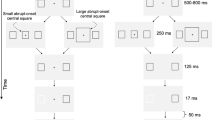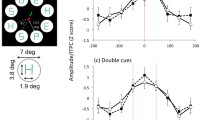Abstract
Selective visual attention involves prioritizing both the location (orienting) and distribution (focusing) of processing. To date, much more research has examined attentional orienting than focusing. One of the most well-established findings is that orienting can be exogenous, as when a unique change in luminance draws attention to a spatial location (e.g., Theeuwes in Atten Percept Psychophys 51:599–606, 1992; Yantis and Jonides in J Exp Psychol Hum Percept Perform 10:601, 1984), and endogenous, as when a red distractor shape diverts attention when one is looking for a red target (e.g., Bacon and Egeth in Percept Psychophys 55:485–496, 1994; Folk et al. in J Exp Psychol Hum Percept Perform 18:1030, 1992). Here we ask whether attentional focusing—the broadening and contracting of prioritized processing—is influenced by the same two factors. Our methodology involved a dual-stream attentional blink task; participants monitored two spatially separated streams of items for two targets that could appear unpredictably either in the same stream or in opposite streams. The spatial distribution of attention was assessed by examining second-target accuracy in relation to inter-target lag and target location (same or opposite streams). In Experiment 1, we found that attentional contracting was more rapid when the targets differed in luminance from the distractor items. In Experiments 2 and 3, we found that the rate of attentional contracting was slower when there were task-relevant distractors in the stream opposite the first target. These results indicate that the rate of attentional focusing, like orienting, can be modulated by both exogenous and endogenous mechanisms.











Similar content being viewed by others
Notes
Several previous studies have provided evidence of such contracting of attention to the T1-stream (e.g., Jefferies et al., 2007, 2015; Jefferies & Di Lollo, 2009; Visser, Bischof, & Di Lollo, 1999). It is assumed that this contracting occurs primarily to optimize T1 identification accuracy. There is also evidence that T1 can be localized prior to being identified (Ghorashi, Jefferies, Kawahara, & Watanabe, 2008; Ghorashi, Enns, Klein, & Di Lollo, 2010), and that attention is deployed to the target’s location even when the target’s identity cannot be reported (Woodman & Luck, 2003).
We thank Elkan Akyürek (personal communication, June 2017) for suggesting temporal integration as a principle on which to explain the present results.
References
Akyürek, E. G., Eshuis, S. A., Nieuwenstein, M. R., Saija, J. D., Başkent, D., & Hommel, B. (2012). Temporal target integration underlies performance at lag 1 in the attentional blink. Journal of Experimental Psychology: Human Perception and Performance, 38, 1448.
Awh, E., & Pashler, H. (2000). Evidence for split attentional foci. Journal of Experimental Psychology: Human Perception and Performance, 26(2), 834–846.
Bacon, W. F., & Egeth, H. E. (1994). Overriding stimulus-driven attentional capture. Perception & Psychophysics, 55, 485–496.
Barriopedro, M. I., & Botella, J. (1998). New evidence for the zoom lens model using the RSVP technique. Perception & Psychophysics, 60, 1406–1414.
Bay, M., & Wyble, B. (2014). The benefit of attention is not diminished when distributed over two simultaneous cues. Attention, Perception, & Psychophysics, 76, 1287–1297.
Benso, F., Turatto, M., Mascetti, G. G., & Umiltà, C. (1998). The time course of attentional focusing. European Journal of Cognitive Psychology, 10, 378–388.
Breitmeyer, B. G., Ehrenstein, A., Pritchard, K., Hiscock, M., & Crisan, J. (1999). The roles of location specificity and masking mechanisms in the attentional blink. Attention, Perception, & Psychophysics, 61, 798–809.
Breitmeyer, B. G., Hoar, W. S., Randall, D. J., & Conte, F. P. (1984). Visual masking: An integrative approach. Oxford: Clarendon Press.
Castiello, U., & Umiltà, C. (1990). Size of the attentional focus and efficiency of processing. Acta Psychologica, 73, 195–209.
Chun, M. M., & Potter, M. C. (1995). A two-stage model for multiple target detection in rapid serial visual presentation. Journal of Experimental Psychology: Human Perception and Performance, 21, 109–127.
Di Lollo, V., Enns, J. T., Yantis, S., & Dechief, L. G. (2000). Response latencies to the onset and offset of visual stimuli. Attention, Perception, & Psychophysics, 62, 218–225.
Egeth, H. (1977). Attention and preattention. Psychology of Learning and Motivation, 11, 277–320.
Egeth, H. E., & Yantis, S. (1997). Visual attention: Control, representation, and time course. Annual Review of Psychology, 48, 269–297.
Eimer, M., & Grubert, A. (2014). Spatial attention can be allocated rapidly and in parallel to new visual objects. Current Biology, 24, 193–198.
Eimer, M., & Kiss, M. (2008). Involuntary attentional capture is determined by task set: Evidence from event-related brain potentials. Journal of Cognitive Neuroscience, 20, 1423–1433.
Eriksen, C. W., & St. James, J. D. (1986). Visual attention within and around the field of focal attention: A zoom lens model. Perception & Psychophysics, 42, 225–240.
Eriksen, C. W., & Yeh, Y-y. (1985). Allocation of attention in the visual field. Journal of Experimental Psychology: Human Perception and Performance, 11, 583–597.
Facoetti, A., Lorusso, M. L., Paganoni, P., Cattaneo, C., Galli, R., & Mascetti, G. G. (2003). The time course of attentional focusing in dyslexic and normally reading children. Brain and Cognition, 53, 181–184.
Folk, C. L., Remington, R. W., & Johnston, J. C. (1992). Involuntary covert orienting is contingent on attentional control settings. Journal of Experimental Psychology: Human Perception and Performance, 18, 1030.
Folk, C. L., Remington, R. W., & Wright, J. H. (1994). The structure of attentional control: contingent attentional capture by apparent motion, abrupt onset, and color. Journal of Experimental Psychology: Human Perception and Performance, 20, 317.
Ghorashi, S., Enns, J. T., Klein, R. M., & Di Lollo, V. (2010). Spatial selection and target identification are separable processes in visual search. Journal of Vision, 10(3), 7.
Ghorashi, S. M. S., Jefferies, L. N., Kawahara, J.-I., & Watanabe, K. (2008). Does attention accompany the conscious awareness of both location and identity of an object. Psyche, 14, 1–13.
Ghorashi, S. M., Zuvic, S. M., Visser, T. A., & Di Lollo, V. (2003). Focal distraction: spatial shifts of attentional focus are not required for contingent capture. Journal of Experimental Psychology: Human Perception and Performance, 29, 78.
Greenwood, P. M., Parasuraman, P., & Haxby, J. V. (1993). Changes in visuospatial attention over the adult lifespan. Neuropsychologia, 31, 471–485.
Hawkins, H. L., Shafto, M. G., & Richardson, K. (1988). Effects of target luminance and cue validity on the latency of visual detection. Perception & Psychophysics, 44(5), 484–492.
Hommel, B., & Akyürek, E. G. (2005). Lag-1 sparing in the attentional blink: Benefits and costs of integrating two events into a single episode. The Quarterly Journal of Experimental Psychology Section A, 58, 1415–1433.
Jans, B., Peters, J. C., & De Weerd, P. (2010). Visual spatial attention to multiple locations at once: The jury is still out. Psychological Review, 117, 637–684.
Jefferies, L. N., & Di Lollo, V. (2009). Linear changes in the spatial extent of the focus of attention across time. Journal of Experimental Psychology: Human Perception and Performance, 35, 1020–1031.
Jefferies, L. N., & Di Lollo, V. (2015). When can spatial attention be deployed in the form of an annulus? Attention, Perception, & Psychophysics, 77, 413–422.
Jefferies, L. N., Enns, J. T., & Di Lollo, V. (2014a). The flexible focus: Whether spatial attention is unitary or divided depends on observer goals. Journal of Experimental Psychology: Human Perception and Performance, 40, 465.
Jefferies, L. N., Ghorashi, S., Kawahara, J-i, & Di Lollo, V. (2007). Ignorance is bliss: The role of observer expectation in dynamic spatial tuning of the attentional focus. Perception & Psychophysics, 69, 1162–1174.
Jefferies, L. N., Gmeindl, L., & Yantis, S. (2014b). Attending to illusory differences in object size. Attention, Perception, & Psychophysics, 76, 1393–1402.
Jefferies, L.N., & Witt, J.B. First unitary, then divided: The temporal dynamics of dividing attention (under review).
Jefferies, L. N., Roggeveen, A. B., Enns, J. T., Bennett, P. J., Sekuler, A. B., & Di Lollo, V. (2015). On the time course of attentional focusing in older adults. Psychological Research, 79, 28–41.
Jonides, J. (1983). Further toward a model of the mind’s eye’s movement. Bulletin of the Psychonomic Society, 21(4), 247–250.
Jonides, J., & Yantis, S. (1988). Uniqueness of abrupt visual onset in capturing attention. Perception & Psychophysics, 43, 346–354.
Kawahara, J. I., & Yamada, Y. (2006). Two noncontiguous locations can be attended concurrently: Evidence from the attentional blink. Psychonomic Bulletin & Review, 13, 594–599.
LaBerge, D. (1983). Spatial extent of attention to letters and words. Journal of Experimental Psychology: Human Perception and Performance, 9, 371.
Lit, A., Young, R. H., & Shaffer, M. (1971). Simple time reaction as a function of luminance for various wavelengths. Attention, Perception, & Psychophysics, 10(6), 397–399.
Lunau, R., & Olivers, C. N. (2010). The attentional blink and lag 1 sparing are nonspatial. Attention, Perception & Psychophysics, 72, 317–325.
Maringelli, F., & Umiltà, C. (1998). The control of the attentional focus. European Journal of Cognitive Psychology, 10, 225–246.
McMains, S. A., & Somers, D. C. (2004). Multiple spotlights of attentional selection in human visual cortex. Neuron, 42, 677–686.
Müller, M. M., Malinowski, P., Gruber, T., & Hillyard, S. A. (2003). Sustained division of the attentional spotlight. Nature, 424, 309–312.
Posner, M. I. (1980). Orienting of attention. Quarterly Journal of Experimental Psychology, 32, 3–25.
Posner, M. I., & Cohen, Y. (1984). Components of visual orienting. Attention and Performance X: Control of Language Processes, 32, 531–556.
Posner, M. I., & Petersen, S. E. (1990). The attention system of the human brain. Annual Review of Neuroscience, 13(1), 25–42.
Posner, M. I., Petersen, S. E., Fox, P. T., & Raichle, M. E. (1988). Localization of cognitive operations in the human brain. Science, 240(4859), 1627.
Posner, M. I., Sheese, B. E., Odludaş, Y., & Tang, Y. (2006). Analyzing and shaping human attentional networks. Neural Networks, 19, 1422–1429.
Posner, M. I., Snyder, C. R., & Davidson, B. J. (1980). Attention and the detection of signals. Journal of Experimental Psychology: General, 109, 160.
Potter, M. C., Chun, M. M., Banks, B. S., & Muckenhoupt, M. (1998). Two attentional deficits in serial target search: The visual attentional blink and an amodal task-switch deficit. Journal of Experimental Psychology. Learning, Memory, and Cognition, 24, 979–992.
Raymond, J. E., Shapiro, K. L., & Arnell, K. M. (1992). Temporary suppression of visual processing in an RSVP task: An attentional blink? Journal of Experimental Psychology: Human Perception and Performance, 18, 849–860.
Remington, R. W., Johnston, J. C., & Yantis, S. (1992). Involuntary attentional capture by abrupt onsets. Attention, Perception, & Psychophysics, 51, 279–290.
Ronconi, L., Gori, S., Ruffino, M., Molteni, M., & Facoetti, A. (2012). Zoom-out attentional impairment in children with autism spectrum disorder. Cortex, 49, 1–9.
Shih, S. I. (2000). Recall of two visual targets embedded in RSVP streams of distractors depends on their temporal and spatial relationship. Perception & Psychophysics, 62, 1348–1355.
Spalek, T. M., Lagroix, H. E., Yanko, M. R., & Di Lollo, V. (2012). Perception of temporal order is impaired during the time course of the attentional blink. Journal of Experimental Psychology: Human Perception and Performance, 38, 402.
Theeuwes, J. (1992). Perceptual selectivity for color and form. Attention, Perception, & Psychophysics, 51, 599–606.
Visser, T. A. W., Bischof, W. F., & Di Lollo, V. (1999a). Attentional switching in spatial and non-spatial domains: evidence from the attentional blink. Psychological Bulletin, 125, 458–469.
Visser, T. A., Zuvic, S. M., Bischof, W. F., & Di Lollo, V. (1999b). The attentional blink with targets in different spatial locations. Psychonomic Bulletin & Review, 6, 432–436.
Weichselgartner, E., & Sperling, G. (1987). Dynamics of automatic and controlled visual attention. Science, 238, 778–781.
Woodman, G. F., & Luck, S. J. (2003). Serial deployment of attention during visual search. Journal of Experimental Psychology: Human Perception and Performance, 29(1), 121.
Woodworth, R. S., & Schlosberg, H. (1954). Experimental Psychology. New Delhi: Oxford & IBH.
Yamada, Y., & Kawahara, J. I. (2007). Dividing attention between two different categories and locations in rapid serial visual presentations. Perception & Psychophysics, 69, 1218–1229.
Yantis, S. (1993). Stimulus-driven attentional capture and attentional control settings. Journal of Experimental Psychology: Human Perception and Performance, 19, 676–681.
Yantis, S., & Jonides, J. (1984). Abrupt visual onsets and selective attention: evidence from visual search. Journal of Experimental Psychology: Human Perception and Performance, 10, 601.
Acknowledgements
This research was supported by Discovery Grants from the Natural Sciences and Engineering Research Council of Canada to V. Di Lollo and J. T. Enns.
Author information
Authors and Affiliations
Corresponding author
Ethics declarations
Ethical approval
All procedures performed in studies involving human participants were in accordance with the ethical standards of the institutional and/or national research committee and with the 1964 Helsinki declaration and its later amendments or comparable ethical standards.
Rights and permissions
About this article
Cite this article
Jefferies, L.N., Enns, J.T. & Di Lollo, V. The exogenous and endogenous control of attentional focusing. Psychological Research 83, 989–1006 (2019). https://doi.org/10.1007/s00426-017-0918-y
Received:
Accepted:
Published:
Issue Date:
DOI: https://doi.org/10.1007/s00426-017-0918-y




